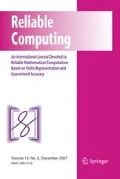Abstract
This paper justifies why an arbitrary precision interval arithmetic is needed. To provide accurate results, interval computations require small input intervals; this explains why bisection is so often employed in interval algorithms. The MPFI library has been built in order to fulfill this need. Indeed, no existing library met the required specifications. The main features of this library are briefly given and a comparison with a fixed-precision interval arithmetic, on a specific problem, is presented. It shows that the overhead due to the multiple precision is completely acceptable. Eventually, some applications based on MPFI are given: robotics, isolation of polynomial real roots (by an algorithm combining symbolic and numerical computations) and approximation of real roots with arbitrary accuracy.
Similar content being viewed by others
References
Aberth, O.: Precise Numerical Methods Using C++, Academic Press, 1998.
Aberth, O. and Schaefer, M. J.: Precise Computation Using Range Arithmetic, via C++, ACM TOMS 18 (4) (1992), pp. 481–491.
Alefeld, G. and Herzberger, J.: Introduction to Interval Analysis, Academic Press, 1983.
Auzinger, W. and Stetter, H. J.: An Elimination Algorithm for the Computation of All Zeros of a System of Multivariate Polynomial Equations, Int. Series in Numerical Mathematics, Birkhäuser 86 (1988), pp. 11–30.
Berz, M. and Hoefkens, J.: Verified High-Order Inversion of Functional Dependencies and Interval Newton Methods, Reliable Computing 7(5) (2001), pp. 379–398.
Bini, D. and Fiorentino, G.: Numerical Computation of Polynomial Tools: MPSolve—Version 2.0, 1998, http://www.dmi.unict.it/-marotta/Articoli/mpsolve.ps.
Brattka, V. and Hertling, P.: Feasible Real Random Access Machines, J. of Complexity 14(4) (1998), pp. 490–526.
Brent, R. P.: A Fortran Multiple-Precision Arithmetic Package, ACM TOMS 4(1978), pp. 57–70.
CANTResearch Group: Arithmos: A Reliable Integrated Computational Environment, University of Antwerpen, Belgium, 2001, http://win-www.uia.ac.be/u/cant/arithmos/.
Collins, G. and Akritas, A.: Polynomial Real Root Isolation Using Descartes’ Rule of Signs, in: SYMSAC, 1976, pp. 272–275.
Connell, A. E. and Corless, R. M.: An Experimental Interval Arithmetic Package in Maple, in: Num. Analysis with Automatic Result Verification, 1993.
Cox, D., Little, J., and O’Shea, D.: Ideals, Varieties, and Algorithms: An Introduction to Computational Algebraic Geometry and Commutative Algebra, Undergraduate Texts in Mathematics, Springer-Verlag, 1992.
Daney, D., Hanrot, G., Lefèvre, V., Pelissier, P., Rouillier, F., and Zimmermann, P.: The MPFR Library, 2001, http://www.mpfr.org/.
Fortune, S.: Polynomial Root Finding Using Iterated Eigenvalue Computation, in: Proc. ISSAC’01, 2001, pp. 121–128.
Geulig, I. and Krämer, W.: Intervallrechnung in Maple—Die Erweiterung intpakX zum Paket intpak der Share-Library, Technical Report 99/2, Universität Karlsruhe, 1999.
Hansen, E.: Global Optimization Using Interval Analysis, Marcel Dekker, 1992.
Hansen, E. and Greenberg, R. I.: An Interval Newton Method, J. of Applied Math. and Computing 12 (1983), pp. 89–98.
Hansen, E. and Sengupta, S.: Bounding Solutions of Systems of Equations Using Interval Analysis, BIT 21(1981), pp. 203–211.
Hickey, T.-J., Ju, Q., and Van Emden, M.-H.: Interval Arithmetic: from Principles to Implementation, J. of ACM 48 (5) (2001), pp. 1038–1068.
Jaulin, L., Kieffer, M., Didrit, O., and Walter, E.: Applied Interval Analysis, Springer Verlag, 2001.
Kearfott, R. B.: Rigorous Global Search: Continuous Problems, Kluwer Academic Publishers, 1996.
Kearfott, R. B., Dawande, M., Du, K.-S., and Hu, C.-Y.: Algorithm 737: INTLIB: A Portable Fortran 77 Interval Standard-Function Library, ACM TOMS 20(4) (1994), pp. 447–459.
Kearfott, R. B. and Walster, G. W.: On Stopping Criteria in Verified Nonlinear Systems or Optimization Algorithms, ACM TOMS 26(3) (2000), pp. 373–389.
Keiper, J.: Interval Arithmetic in Mathematica, Interval Computations3 (1993), pp. 76–87.
Klatte, R., Kulisch, U., Lawo, C., Rauch, M., and Wiethoff, A.: C–XSC: A C++ Class Library for Extended Scientific Computing, Springer Verlag, 1993.
Krämer, W., Kulisch, U., and Lohner, R.: Numerical Toolbox for Verified Computing II— Advanced Numerical Problems, Springer, 2002.
Knueppel, O.: PROFIL/BIAS—A Fast Interval Library, Computing 53(3–4) (1994), pp. 277– 287.
Langlois, P. and Revol, N.:Validating Polynomial Numerical Computations with Complementary Automatic Methods, submitted to Mathematics and Computers in Simulation, 4th revision. INRIA research report RR–4205, 2001, http://www.inria.fr/rrrt/rr-4205.html.
Lerch, M., Tischler, G., Wolff von Gudenberg, J., Hofschuster, W., and Krämer, W.: The Interval Library filib++ 2.0, Preprint 2001/4, Universität Wuppertal, 2001, http://www.math.uni-wuppertal.de/org/WRST/software/filib.html.
Merlet, J. P.: Les Robots parallèles, Robotique, Hermès Paris, 1990.
Moore, R. E.: Interval Analysis, Prentice Hall, 1966.
Müller, N.: The iRRAM: Exact Arithmetic in C++, in: Workshop on Constructivity and Complexity in Analysis, Swansea, 2000.
Neumaier, A.: Interval Methods for Systems of Equations, Cambridge University Press, 1990.
Revol, N.: Interval Newton Iteration in Multiple Precision for the Univariate Case, Numerical Algorithms 34 (2) (2003), pp. 417–426.
Revol, N. and Rouillier, F.: The MPFI Library, 2001, http://perso.ens-lyon.fr/nathalie.revol/software.html.
Rouillier, F.: Solving Zero-Dimensional Systems through the Rational Univariate Representation, Journal of Applicable Algebra in Engineering, Communication and Computing 9 (5) (1999), pp. 433–461.
Rouillier, F.: RS / Real Solutions, 2000, http://fgbrs.lip6.fr/-rouillie/Software/RS/.
Rouillier, F. and Zimmermann, P.: Efficient Isolation of Polynomial Real Roots, J. of Computational and Applied Math. 162 (1) (2004), pp. 33–50.
Rump, S.: Fast and Parallel Interval Arithmetic, BIT 39(3) (1999), pp. 534–554.
Rump, S.: INTLAB—Interval Laboratory, in: Csendes, T. (ed.), Developments in Reliable Computing, Kluwer Academic Publishers, 1999, pp. 77–104.
Sun Microsystems: C++ Interval Arithmetic Programming Reference, 2000.
Vincent, A.-H.: Sur la résolution des équations numériques, Journal de Mathématiques Pures et Appliquées (1836), pp. 341–372.
Yohe, J. M.: Portable Software for Interval Arithmetic, Computing, Suppl. 2 (1980), pp. 211–229.
Author information
Authors and Affiliations
Corresponding author
Additional information
This work was done while N. Revol was a member of the ANO Laboratory, University of Lille, France, on sabbatical leave within the Arenaire project.
This work was done while F. Rouillier belonged to the Spaces project, LORIA and LIP6, France.
Rights and permissions
About this article
Cite this article
Revol, N., Rouillier, F. Motivations for an Arbitrary Precision Interval Arithmetic and the MPFI Library. Reliable Comput 11, 275–290 (2005). https://doi.org/10.1007/s11155-005-6891-y
Received:
Accepted:
Issue Date:
DOI: https://doi.org/10.1007/s11155-005-6891-y




